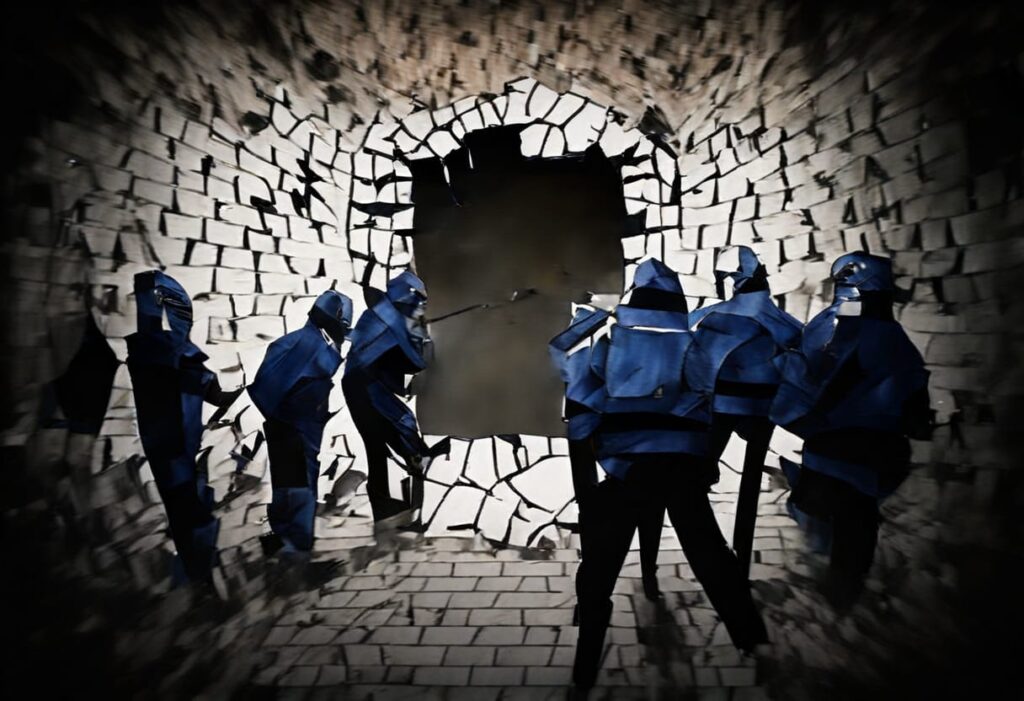
The Third Acceptance of alternative centrism is the acceptance that the Establishment Centre is correct when they speak of the importance of peace.
The Establishment Right and the Establishment Left love to fight. Both feel that they have a legitimate right to rule and are willing to assert that right with force. Thus, much of the march of history is one ruling class fighting a would-be ruling class, back and forth, over years, decades and centuries. Whether it’s nations or classes doesn’t matter. The war to impose order and to be free from someone else’s imposed order goes on and on. Without a peacemaking force that brings both sides to the negotiating table, either side will escalate conflict as soon as they perceive themselves to have an advantage.
This leads to endless war. The logic of extremism is war – the more extreme, the less room for negotiating, thus the more force and aggression. Both the Left and the Right see the will to negotiate peace as weakness. But without peace, nothing gets built, everything gets destroyed. If the Establishment Right and the Establishment Left were the only players in history, it would be a never-ending battlefield, where peace was only achieved by the strong and even then was always temporary. They would lay waste to every facet of civilisation in their fervour to get an edge over the enemy.
When the major political forces act like this, no-one can be wealthy. All wealth is commandeered for the various war efforts, and then destroyed in the war itself. Bombings, artillery strikes and battles destroy buildings and infrastructure. Medical costs from war are extreme, and wounded veterans are much less likely to go on to produce an economic surplus. And of course dead people can’t produce any wealth at all.
Worst of all, the infighting risks that one gets conquered by outsiders. Outside forces that would steal a nation’s wealth take notice when that nation’s Establishment Right and Left are fighting each other. They then swoop in to wipe out the survivors.
This process leads to the rise of the Establishment Centre. The Establishment Centre is not interested in arguments about how the Establishment Right represents quality (or order/stagnation) and the Establishment Left quantity (or freedom/chaos) and blah blah blah. They have little time for the abstract, let alone the metaphysical. They are immensely practical – and equally godless.
The really good thing about the Establishment Centre is that they succeed in getting the other wings of the Establishment to agree on the value of peace, and thereby to negotiate instead of fight. In so doing, they end the cycle of violence between those two wings. This gives them a very special role in the historical development of human society. If the Establishment Centre can negotiate peace between the other wings of the Establishment, prosperity inevitably follows.

Solon might have been the first Establishment Centrist in Western history. He was brought to power at a time when there was immense discord between the wealthy and the poor in Athens. The city-state was on the brink of civil war on account of widespread debt slavery. Both sides trusted him to be an impartial arbiter between them.
The genius of Solon was that he was able to find an acceptable balance between the excessive order of his predecessor Draco, and the excessive chaos of the disadvantaged who wanted to redistribute everything. This did not satisfy the extremists on both sides, but it satisfied enough of the moderates of both sides that they agreed peace was better than further conflict. The influence of Solon’s reforms led directly to the Golden Age of Athens, and he is remembered as one of the Seven Sages of Athens.
The Third Acceptance, then, accepts that peace is more valuable than either excessive order or excessive freedom, and that peace is usually best found by finding the right balance between order and freedom. This Third Acceptance is the key to understanding why the Establishment itself is so enduring – its centre acts to correct any excesses that might form in either wing, so that the overall edifice remains balanced.
In today’s modern democracies, the Establishment Centre often ends up taking control by virtue of controlling the balance of power. Because the most stubborn, irrational and antisocial elements drift to the wings (this is as true of the Alternative as it is of the Establishment), the Establishment Centre often finds itself with more reasonable and intelligent people than either wing. As such, they often come to be seen as the natural leaders of the Establishment.
In New Zealand, this phenomenon is seen with Winston Peters, leader of the pseudo-nationalist New Zealand First party. As an Establishment Centrist, he often finds himself holding the balance of power with 6-7% of the vote. This means that he can play the Establishment Right and Establishment Left off against each other to get the best deal. It also gives him veto power over the makeup of the government. This position in the centre is so powerful that, even after 30 years of broken promises and sleaze, he still cannot be dispensed with. European countries with similar systems often have similar problems.
The phenomenon is not as obvious in America and Britain, because America has a two-party system and Britain has a First Past the Post-style system. Consequently, the largest party in any general election in either country seldom has to rely on the support of the Establishment Centre. It could be, and has been, argued that such an arrangement is inherently unstable and leads to warmongering (the history of America and Britain since the founding of the Federal Reserve certainly supports this argument).
The Establishment Centre, in whatever time and place, is usually full of merchants. If no aristocrats are available to stop the timocrats from fighting, the oligarchs have to step up and find the way to a peace agreement. The Right and the Left might criticise the merchantry as unprincipled, but the merchants themselves would counter that firmly-held principles lead only to bloodshed. Better for everyone to just chill out and trade.
Generally this arrangement has indeed brought peace. It could be argued that historical examples of lengthy peace were often examples of times when the Establishment Centre was in charge. The times of the greatest expansion – and profits – of the British Empire was the time inbetween the Napoleonic Wars and World War I, when men like Nathan Rothschild had the greatest influence. After World War II, another lengthy peace followed the Establishment Centre’s assertion of liberal democracy.
The alternatives to the Establishment Centre finding peace are continual crackdowns and oppression under the Establishment Right, revolutionary chaos under the Establishment Left, or endless warfare under them both. So the Establishment Centre often ends up coming to power, as Solon did, with a mandate from the rest of the Establishment to negotiate peace. The Third Acceptance accepts that this process is natural and good.
There is a problem with eternal peace, though – it leads to the Establishment coming together against the people. This is a unique form of corruption that manifests as degeneracy. It is this process of degeneration and its results that are rejected by the alternative centrist in the Third Rejection.
*
This chapter is from The Alternative Centrist Manifesto, the upcoming work of political philosophy that offers the answers to the political problems of the West.
*
For more of VJM’s ideas, see his work on other platforms!
For even more of VJM’s ideas, buy one of his books!
*
If you enjoyed reading this piece, buy a compilation of our best pieces from previous years!
Best VJMP Essays and Articles of 2023
Best VJMP Essays and Articles of 2022
Best VJMP Essays and Articles of 2021
Best VJMP Essays and Articles of 2020
Best VJMP Essays and Articles of 2019
Best VJMP Essays and Articles of 2018
Best VJMP Essays and Articles of 2017





